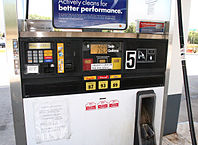Author David Graser, Yavapai College, Prescott, AZ (David_Graser@yc.edu)
Abstract

This project uses the observation that my 1995 Ford Ranger runs better on higher octane gasoline. Over the course of 13 years, I have noticed that it runs better with an octane of about 88.5 octane. In this project, students calculate the cheapest way to fill their tank with 88 octane gasoline blended from the three available octanes: 87 octane, 89 octane and 91 octane. To make the project unique to each student, they use the capacity of their own tank as well as the prices from their favorite gas station.
Depending on whether the prices for the components are equally spaced in price, students get a dependent system of equation that can lead to some very surprising results.
- Content Area – College Algebra, Finite Math
- Time Frame – 2 to 3 weeks with mini-lectures –
- Published – May 28, 2008
- Keywords – system of linear equations, matrices, row echelon form, systems with an infinite number of solutions
Project Content
Scaffolding Resources
Technology Assignment: Substitution (DOC | PDF) This assignment introduces students to documenting their work with Mathtype.
Technology Assignment: Gauss-Jordan Method (DOC | PDF | Video) The goal of this tech assignment is to help students put a matrix into row echelon form. Once they have done this, they document their work using Mathtype.
Technology Assignment: Row Operations on the Ti-83 and in Mathtype (DOC | PDF) In this assignment, students create their own system of equations and then use row operations to solve the system. This assignment is almost identical to the one above, but this version includes instructions for carrying out the row operations on a TI graphing calculator and documenting the steps using Mathtype.
Technology Assignment: Write and Solve a System Using Excel (DOC | PDF) This assignment is designed to get students to write down their system of equations for the project so that they can be checked before turning in the final assessment for the project.
Dependent Systems Handout (PDF) This handout demonstrates how to come up with and solve an example with two equations in three variables. The basic strategy in it can be used to solve the problem in the project.
Reduced Row Echelon Form on a TI Graphing Calculator (PDF) This document takes a student through the steps of putting an augmented matrix into a TI calculator and using the rref command to find the reduced row echelon form for the augmented matrix.
Reduced Row Echelon Form in Excel (PDF) This document shows how to do row operations in Excel in order to end up with the reduced row echelon form of an augmented matrix.
Row Operations on the TI-83 (Video)
RREF in Excel (2 equations, 2 variables) (Video)
RREF in Excel (3 equations, 3 variables) (Video)
Notes
- If prices and octanes are equally spaced, all solutions cost exactly the same. If they are not equally spaced, then there is a mixture that is cheapest that can be estimated using a table with integer numbers of gallons. Students have a tendency to oversimplify the problem and mix half a tank of 89 and half a tank of 87. This has the proper octane, but might not be the cheapest.
